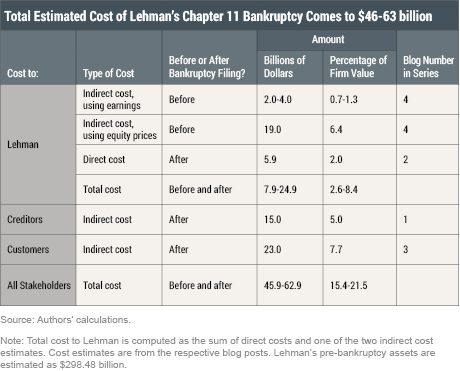Lehman Brothers Holdings Inc. (LBHI) filed for Chapter 11 bankruptcy protection on September 15, 2008, initiating one of the largest and most complex bankruptcy proceedings in history. Recovery prospects for creditors, who submitted about $1.2 trillion of claims against the Lehman estate, were quite bleak. This week, we will publish a series of four posts that provide an assessment of the value lost to Lehman, its creditors, and other stakeholders now that the bankruptcy proceedings are winding down. Where appropriate, we also consider the liquidation of Lehman’s investment banking affiliate, which occurred in separate proceedings under the Securities Investor Protection Act (SIPA).
How Is Value Destroyed in Bankruptcy?
In the bankruptcy literature, value destruction is identified with the direct and indirect costs of bankruptcy. The direct costs are the expenses paid to third parties, such as legal and accounting professionals, for services provided during bankruptcy. The indirect costs are opportunity costs of various kinds that impinge on the firm, its creditors, and its stakeholders. Prior to bankruptcy, customers stop buying products and services, lenders demand stricter terms, and managers get distracted, reducing the distressed firm’s profitability. Following a bankruptcy filing, the firm’s customers and clients may not be able to purchase the same services elsewhere, while employees may suffer wage losses if their skills are not transferable to other firms. In addition, creditors may lose the value of assets trapped in lengthy bankruptcy proceedings, either because the assets cannot be located or because of disagreements with the bankruptcy estate.
The literature further counts the loss of tax credits that the firm would have received, had it not been bankrupt, as a component of value destruction. While we do not have reliable data on Lehman’s lost tax credits in bankruptcy, Lehman estimated in the third quarter of 2008 that these would be minimal, assuring that its taxable income would be sufficient to absorb deferred tax assets.
The ensuing posts discuss these components of value destruction. The first post examines how creditors fared in the Chapter 11 proceedings, taking the time value of money and liquidity value of assets into account. The second post tabulates the direct costs of Lehman’s bankruptcy, which are observable and hence relatively straightforward to estimate. The third post considers losses to customers and other stakeholders because of the destruction of specific relationships. The final post assesses the indirect costs of Lehman’s bankruptcy, which are difficult to estimate and hard to distinguish from the firm’s general economic distress.
Below is a short summary of the posts in the series, followed by a brief discussion that brings the findings together:
1. Creditor Recovery in Lehman’s Bankruptcy
In nominal terms, creditors fared better than initially expected, recovering about one-third or more of their claims, compared to an estimate of 10 percent at the beginning of the bankruptcy proceedings. A major reason for the improved recovery was the strong rebound in asset values during the lengthy bankruptcy process. However, as a result of the delays, the present value of recovery for Chapter 11 creditors was appreciably lower, and creditors lost the liquidity value of their assets over the resolution period.
2. Lehman’s Bankruptcy Expenses
The direct costs of Lehman’s bankruptcy include professional and consulting fees to third-party professionals, compensation and benefits to employees involved in administering the bankruptcy, and outsourced service costs. Given its complexity, lawyers involved in the bankruptcy initially expected the fees to be large and, indeed, we find that fees were substantial, amounting to about $6 billion for Chapter 11. These numbers reinforce recent concerns about rising bankruptcy costs as a consequence of the increasing size and complexity of distressed companies’ capital structures.
3. Customer and Employee Losses in Lehman’s Bankruptcy
What were the losses to Lehman’s customers, clients, and employees as a result of its bankruptcy? We find that Lehman’s investment banking customers were generally able to transfer their accounts to solvent broker-dealers, with the exception of some institutional customers who relied on specialized brokerage services. In contrast, Lehman’s equity underwriting clients lost substantial value. Lehman’s employees mostly found jobs at other banks, but some had difficulty finding jobs in the financial industry, whether due to the downturn in the financial sector or a lack of transferable skills.
4. Indirect Costs of Lehman’s Bankruptcy
We estimate the indirect costs of bankruptcy based on Lehman’s earnings shortfalls and the change in Lehman’s equity market value in the two quarters prior to bankruptcy. Using the first method, Lehman’s indirect costs, relative to those of other large financial firms, were less than 1.5 percent of its pre-bankruptcy assets. By comparison, losses in its equity market value were about 6.5 percent of its pre-bankruptcy assets. With either method, Lehman’s indirect costs were lower than those found by prior studies, mainly owing to Lehman’s short period of pre-bankruptcy distress.
Total Value Destruction in Lehman’s Chapter 11 Bankruptcy
Our estimate of the value destruction from the Lehman bankruptcy is substantial, although some losses were likely due to economic distress, or represented value transfers to other parties. In particular, we estimate value destruction to be on the order of $46 billion to $63 billion, or between 15 percent and 21 percent of Lehman’s pre-bankruptcy consolidated assets. These estimates exclude fees and expenses from the SIPA proceedings, which are an additional $1.4 billion, and the costs of resolving Lehman’s subsidiaries outside of U.S. legal jurisdictions.
The main sources of value destruction are as follows: $6 billion from fees and expenses in Chapter 11 alone, establishing a hard lower bound for our assessment; $15 billion attributable to liquidity costs borne by creditors for having their assets tied up in the bankruptcy proceedings; up to $19 billion in indirect costs; and a further $23 billion from lost relationships between Lehman and its equity underwriting clients.

Disclaimer
The views expressed in this post are those of the authors and do not necessarily reflect the position of the Federal Reserve Bank of New York or the Federal Reserve System. Any errors or omissions are the responsibility of the authors.

Erin Denison is a senior research analyst in the Federal Reserve Bank of New York’s Research and Statistics Group.

Michael J. Fleming is a vice president in the Bank’s Research and Statistics Group.

Asani Sarkar is an assistant vice president in the Bank’s Research and Statistics Group.
How to cite this blog post:
Erin Denison, Michael J. Fleming, and Asani Sarkar, “How Much Value Was Destroyed by the Lehman Bankruptcy?,” Federal Reserve Bank of New York Liberty Street Economics (blog), January 14, 2019, https://libertystreeteconomics.newyorkfed.org/2019/01/how-much-value-was-destroyed-by-the-lehman-bankruptcy.html.















 RSS Feed
RSS Feed Follow Liberty Street Economics
Follow Liberty Street Economics
Thank you for your feedback. We agree it’s interesting to think about the alternatives when no formal bankruptcy process, such as chapter 11, exists. One alternative is an out-of-court settlement, such as an exchange offer. Evidence shows that the direct costs can be lower for exchange offers compared to chapter 11. The possibility you suggest — that creditors seize assets on an individual basis — would likely result in significant litigation over claim priority, resulting in delays and legal expenses. Moreover, these alternatives may not be feasible for a large, complex firm such as Lehman. In any case, these are complicated issues, and beyond the scope of our current focus.
This comment on Lehman suffers without a simultaneous analysis of the value destruction without bankruptcy, when the creditors would have raced each other to seize assets.